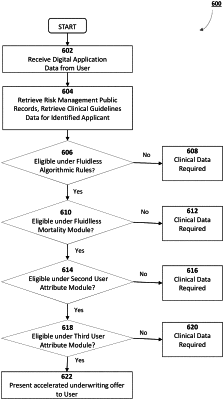| CPC G16H 10/60 (2018.01) [G06N 20/00 (2019.01); G16H 10/20 (2018.01); G16H 20/10 (2018.01); G16H 50/70 (2018.01)] | 21 Claims |

|
1. A method for processing an electronic application missing clinical data, the method comprising:
receiving, by a server, information for an electronic application from a user device, wherein the information for the electronic application excludes clinical data for an applicant;
upon receiving the information for the electronic application from the user display device, retrieving, by the server, public data identified with the applicant of the electronic application from one or more third party sources;
executing, by the server, a first predictive machine learning model configured to determine a first risk rank representative of a mortality risk for the electronic application and to classify the electronic application into one of a first high risk group and a first low risk group based upon the first risk rank,
wherein the first predictive machine learning model is trained by inputting into the first predictive machine learning model a plurality of historical application records wherein each historical application record is supplemented with public data identified with an applicant of the respective historical application record received from the one or more third party sources, wherein feature selection for the first predictive machine learning model is configured to exclude all clinical assessment attributes of the historical application records and configured to select attributes of the public data with highest importance based on mortality risk as variables of the first predictive machine learning model;
executing, by the server, a second predictive machine learning model configured to determine a second risk rank representative of a smoking propensity of the electronic application and to classify the electronic application into one of a second high risk group and a second low risk group based upon the second risk rank;
executing, by the server, a third predictive machine learning model configured to determine a third risk rank representative of prescription drug data of the electronic application, and to classify the electronic application into one of a third high risk group and a third low risk group based upon the third risk rank; and
when the server classifies the electronic application into all of the first low risk group, the second low risk group, and the third low risk group, generating, by the server, a user interface that displays information associated with an accelerated application offer.
|